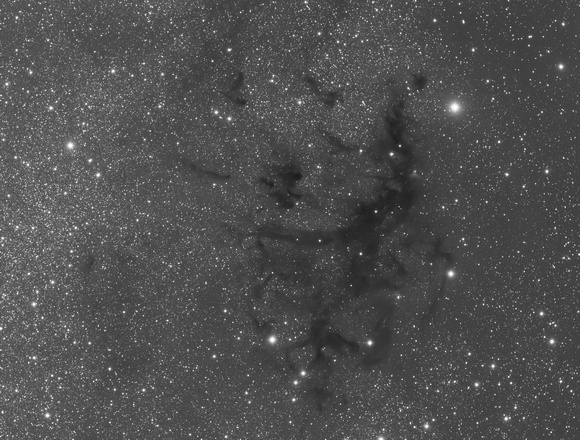LDN 673 is a lovely dark nebula complex in Aquila, not far from Altair.
This image is a reshoot because I wasn't very happy with
the version I did two years ago.
I haven't been very satisfied with my images lately, and during a two-week-long 'timeout' in Germany (it's a long story) I had some time to think about things. The main thing that bothered me was the background noise (grainy stuff in the background) in my images. I approached it in the following ways:
- Increase the subexposure length from 5 minutes to 8 minutes, thus reducing the read noise contribution to the final image. I might go to longer exposure times if I can keep brighter stars out of the image.
- Use proper dark frames and proper flat dark frames. I used to just use bias frames in place of darks and flat darks - no more.
- Use a Quadratic B-Spline for interpolation during image processing. I used to use nearest neighbor interpolation, but this comparison set me straight. The increase in FWHM is something I can deal with for now.
While I don't know which one of these changes had the biggest impact, I am very happy with the outcome.
Independent of all this, I also experimented with a drizzle technique. I am not sure how accurate my 'ghetto' implementation is, but the final image looks what I expect a 2x drizzled image to look like. The jpg you see here was reduced to 75% of that 2x drizzled image (=150% of the native image scale).
Technical details:
Date: July 15, 2015
Time: 11:00 pm - 2:45 am
Camera: SBIG STF-8300M
CCD Temperature: -10 C
Optics: Televue 127is (native)
Filter: Astronomik L
Light frames: 23x8 min
Dark frames: 50
Flat frames: 25
Flat darks: 25
Binning: 1x1
Guiding: Orion SSAG @ Orion finder (~162 mm)
Mount: AP Mach 1
Dithering: Manual
Processing: Stacking in CCDStack, Curves, Levels, and very gentle noise removal actions in PSCS6.
Other notes:
This was an 'emergency' outing as I dropped the ball during an outing on July 11th. I was on the mountain that night, but the satellite loop showed clouds approaching, so I didn't even set up. Reviewing the night's satellite data the next morning it turned out that those clouds slowed down significantly, and I thus missed a prime imaging opportunity. Consequently, I took this image during the week - on Wednesday night. My head hit the pillow at 5 am only to awaken at 8:30 am for work.
The mount put up a jaw dropping performance. During one frame, the RMS guide error was 0.04 pixels which at 6.62quot;/pixel comes out to lt;0.3quot; - I never thought the Mach 1 would be this good.
A hummingbird hawk moth was performing dive bombing exercises on me for most of the night.


